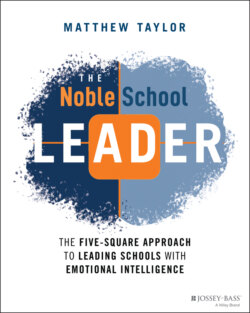Читать книгу The Noble School Leader - Matthew Taylor - Страница 30
Endnotes
Оглавление1 1. McCleskey, J.A. (2014). Situational, transformational, and transactional leadership and leadership development. Journal of Business Studies Quarterly 5(4), 6–9.; Spahr, P. (November 25, 2014). What is Transactional Leadership? How Structure Leads to Results. Retrieved November 8, 2016, from http://online.stu.edu/transactional-leadership/ (accessed 18 November 2016); Hargis, M.B., Wyatt, J.D., and Piotrowski, C. (2011). Developing leaders: Examining the role of transactional and transformational leadership across contexts business. Organization Development Journal 29 (3): 51–66.
2 2. Heath, C. and Heath, D. (2010). Switch: How to Change Things When Change Is Hard. New York: Random House.
3 3. CT3 Web Admin (2018). A powerful paradigm shift for educators. https://www.ct3education.com/2018/05/08/a-powerful-paradigm-shift-for-educators/.
4 4. Ibid.
5 5. Goleman, D., Boyatzis, R., and McKee, A. (2002). Primal leadership: Learning to Lead with Emotional Intelligence. Cambridge, MA: Harvard Business School Press.
6 6. Charan, R., Drotter, S., and Noel, J. (2011). The Leadership Pipeline: How to Build the Leadership Powered Company, Second Edition. San Francisco: Wiley; Batista, E. (2013). Doing less, leading more. Harvard Business Review https://hbr.org/2013/12/doing-less-leading-more.
7 7. Mount, P. and Tardanico, S. (2014). Beating the impostor phenomenon. Greensboro, NC: Center for Creative Leadership; Mount, P. (2015). Impostor phenomenon. Training Journal, 5(8).
8 8. Boyatzis, R. and McKee, A. (2005). Resonant Leadership: Renewing Yourself and Connecting with Others Through Mindfulness, Hope, and Compassion. Cambridge, MA: Harvard Business School Press.
9 9. Zone of proximal development. (2009). Penguin Dictionary of Psychology. Retrieved from Credo Reference database Affective Domain.
10 10. Bloom, B.S. (Ed.), Engelhart, M.D., Furst, E.J., Hill, W.H. et al. (1956). Taxonomy of Educational Objectives, Handbook I: The Cognitive Domain. New York: David McKay Co Inc.
11 11. Conway, M.A., Anderson, S.J., Larsen, S.F. et al. (1994). The formation of flash bulb memories. Memory and Cognition. 22 (3): 326–343. doi:10.3758/BF03200860. PMID 8007835.
12 12. Karen, R. (1998). Becoming Attached: First Relationships and How They Shape Our Capacity to Love. New York: Oxford University Press.
13 13. Boyatzis, R. The Positive (PEA) and Negative (NEA) Emotional Attractors. Coursera. Case Western Reserve University. https://www.coursera.org/lecture/emotional-intelligence-leadership/watch-the-positive-pea-and-negative-nea-emotional-attractors-4GRcY.
14 14. Goleman, D. and Boyatzis, R. (2008). Social intelligence and the biology of leadership. Harvard Business Review magazine.
15 15. Perrius, C. (2014). An integrated approach to improving school systems. National Equity Project. https://blog.nationalequityproject.org/2011/05/23/an-integrated-approach-to-improving-school-systems/.
16 16. Goleman, D., Boyatzis, R., and McKee, A. (2001). Primal leadership: the hidden driver of great performance. Harvard Business Review magazine (December).
